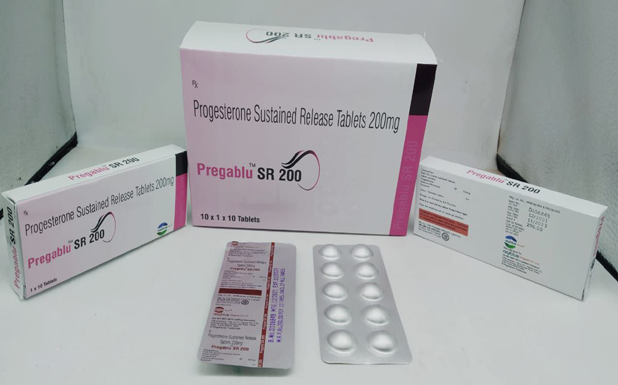Tablet Presentation
Each Sustained Release Tablet Contains: Progesterone IP 200 mgProgesterone is a hormone that occurs naturally in females, and is essential for endometrial receptivity, embryo implantation, and the successful establishment of pregnancy. A low progesterone concentration or an insufficient response to progesterone can cause infertility and pregnancy loss. Progesterone is used in various contraceptive preparations to prevent ovulation and fertilization.
Indications
- Prevention of endometrial hyperplasia
- Secondary amenorrhea
- Reduces infertility in women
- Dysfunctional uterine bleeding
- Endometriosis
Mechanism of action
Progesterone is the main hormone of the corpus luteum and the placenta. It acts on the uterus by changing the proliferative phase to the secretory phase of the endometrium (inner mucous lining of the uterus). This hormone, stimulated by a hormone called luteinizing hormone (LH) is the main hormone during the secretory phase to prepare the corpus luteum and the endometrium for implantation of a fertilized ovum. As the luteal phase concludes, the progesterone hormone sends negative feedback to the anterior pituitary gland in the brain to decrease FSH (follicle stimulating hormone) and LH (luteinizing hormone) levels. This prevents ovulation and maturation of oocytes (immature egg cells). The endometrium then prepares for pregnancy by increasing its vascularity (blood vessels) and stimulating mucous secretion. This process occurs by progesterone stimulating the endometrium to decrease endometrial proliferation, leading to a decreased uterine lining thickness, developing more complex uterine glands, collecting energy in the form of glycogen, and providing more uterine blood vessel surface area suitable for supporting a growing embryo. As opposed to cervical mucous changes observed during the proliferative phase and ovulation, progesterone decreases and thickens the cervical mucus, rendering it less elastic. This change occurs because the fertilization time period has passed, and a specific consistency of mucous amenable to sperm entry is no longer required.
Pharmacokinetics
The oral bioavailability of progesterone is very low. the bioavailability of oral progesterone as less than 10%. The very low bioavailability of oral progesterone is due to the fact that it is poorly absorbed from the gastrointestinal tract and undergoes massive metabolism, resulting in almost complete inactivation during the first pass through the liver. Progesterone is mainly metabolized by the liver. After oral administration, the major plasma metabolites found are 20 a hydroxy-Δ4 a-prenolone and 5 a-dihydroprogesterone. Some progesterone metabolites are found excreted in the bile and these metabolites may be deconjugated and subsequently metabolized in the gut by reduction, dehydroxylation, and epimerization. Progesterone metabolites are excreted mainly by the kidneys. Urinary elimination is observed for 95% of patients in the form of glycuroconjugated metabolites. Elimination half-life of progesterone is approximately 5 hours when taken with food.
Side Effects
- Bloating
- Abdominal cramps
- Pain in stomach
- Constipation
- Diarrhoea
- Drowsiness
- Loss interest in sex
- Vaginal discharge
Contraindication
- Hypersensitivity to progesterone or progestogens
- Prevention of cardiovascular disease (a Black Box warning)
- Thrombophlebitis
- Breast cancer
- Reproductive organ cancers
- Cerebral hemorrhage
- Impaired liver function or disease
- Undiagnosed vaginal bleeding
Disclaimer:The data uploaded is made from content already available on internet.The company holds no right of it and is not responsible for any wrong information.
